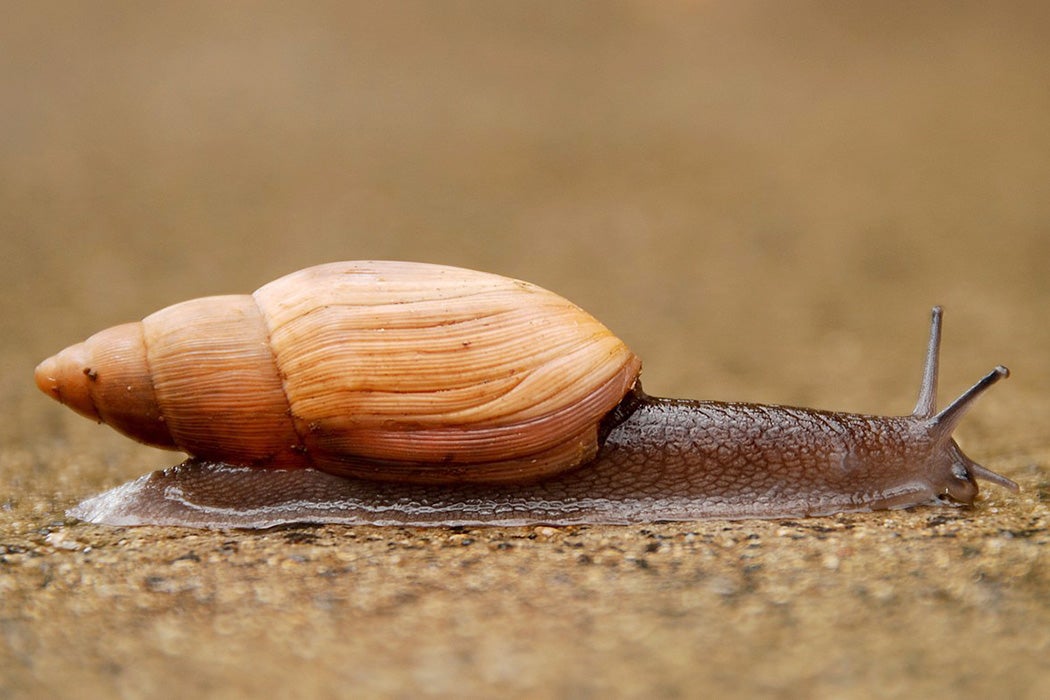Are we talking enough about snail slime?
Perhaps you’ve spotted the silvery trails in gardens, on sidewalks, or tree trunks. The dried mucus left by passing snails and slugs is especially visible when the sun is low. Gardeners despise such trails, interpreting them as signs of nocturnally voracious creatures in the herbaceous border. But lately people have been using snail slime for…skin care. “Mucus” and “slime” evidently having negative connotations, such products are marketed as “snail mucin” or “snail secretion filtrate.”
The mucus created by gastropods is marvelous, multipurpose stuff. A complex mixture of proteins, enzymes, peptides, and trace minerals, gelatinous snail mucus is produced both externally and internally. The external version is what makes the slime trails: it acts both as glue and lubricant. Mucus also protects the skin, keeping snails hydrated and acting as a barrier to infections and predators.
This slime is also information rich. Land snails, who are mostly hermaphroditic, find each other by following the chemical highway of mucus. Before copulation, snails and slugs sniff and taste each other’s mucus for hours. Some species of snails produce “love darts” that are coated with mucus before being fired into the bodies of their mates.The mucus contains hormones that switch off the mate’s sperm-destroying abilities—it’s complicated—thus allowing fertilization.
It follows that if snails of the same species can follow each other’s slime trails, then perhaps so can others. Many gastropods are vegetarians, but some eat other gastropods. The Rosy Wolf Snail (Euglandina rosea) is one of these predatory land snails. Snails are notoriously un-speedy, but you don’t want one of these on your trail: they can climb trees and hunt underwater. The species is native to the southeastern US, but they’ve been introduced elsewhere.
In the 1950s, Rosy Wolf Snails were released in Hawaiʻi to go after the introduced Giant African Snail (Lissachatina fulica). The GAS, as the USDA has been known to call it, was introduced to Hawaiʻi in the mid 1930s as a garden ornamental. (Hey, wouldn’t this garden look great with an exotic 8-inch snail puttering around in it?) Unfortunately, GAS like to eat everything—at least 500 species of plants—and can even cause structural damage to stucco and plaster. They also carry a parasitic nematode that can causes meningitis in humans. In addition to being invasive in Hawaiʻi, GAS are now a problem in Florida, the Caribbean, and South America.
Unfortunately, Rosy Wolf Snails didn’t favor Giant African Snails as food. But they liked eating a lot of the other snails found in Hawaiʻi. As a result of the introduction, the Rosy Wolf is now considered one of the most invasive snail species in the world, right up there with GAS. Rosy Wolfs have contributed to the “decline and extinction of many endemic snails on the islands of Hawaii, Tahiti, Moorea, and other Pacific islands,” writes biologist Elizabeth C. Davis-Berg.
Weekly Newsletter
Why are these snails so good at finding other snails? It’s the slime. But not just the slime: it’s knowing which direction to follow once it runs across a slime trail. In a very slimy experiment, Davis-Berg showed that Rosy Wolf Snails “are robust generalist predators, capable of successfully following native [in Florida] and non-native [in Kansas] snails, and should not be introduced as biologic control agents.”
But getting back to snail-sliming your skin… Traditional Chinese medicine has long incorporated snail slime in a variety of uses. The ancient Greeks used snail slime to reduce inflammation. More recently, snail slime was taken up for skin-care purposes in South Korea. From there, the snail mucin fad was picked up by “Skin Tok” and other social media. It’s collected at snail farms—the snails themselves destined for human consumption—and processed. Mucin is marketed for purposes of hydration, wound-repair, and wrinkle-vanquishing. It’s also said to be anti-microbial, antioxidant, and possibly even anti-tumor.
It certainly seems to be some these things for snails. But not even snails have figured out how be ageless.
Editor’s note: This article has been updated to correct the spelling of “mucus.”







